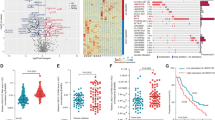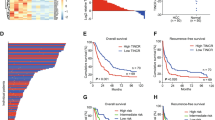Abstract
Hepatocellular carcinoma (HCC) is the most common form of liver cancer. Because of the relatively chemotherapy-refractory nature of HCC and significant potential poor hepatic reserve, chemotherapy has not been used consistently in the treatment of HCC. Effective new drugs for HCC are urgently needed. Teriflunomide, which was approved for the treatment of relapsing forms of multiple sclerosis (MS), has been identified as a potential antineoplastic drug. Long noncoding RNAs (lncRNAs) are a novel class of RNA molecules defined as transcripts longer than 200 nucleotides that lack protein coding potential. In this study, we investigated the ability of teriflunomide to act as an antineoplastic drug by examining the effects of teriflunomide treatment on HCC cells. Teriflunomide strongly inhibited the proliferation of HCC cells, induced cell apoptosis and induced cell accumulation in S phases of the cell cycle. LncRNA and mRNA expression profiles of HCC cells treated with teriflunomide compared with controls were performed by using microarray analysis. For comparison, the differentially expressed mRNAs were annotated by using gene ontology (GO) and pathway analyses. The microarray revealed that 2085 lncRNAs and 1561 mRNAs differed in the cells treated with teriflunomide compared with controls. Several GO terms including protein folding, mitochondrial outer membrane, transmembrane receptor protein phosphatase activity, negative regulation of cellular biosynthetic process, DNA packaging complex, and receptor signaling protein activity were enriched in gene lists, suggesting a potential correlation with the action mechanism of teriflunomide. Pathway analysis then demonstrated that JAK-STAT signaling pathway may play important roles in the cell apoptosis induced by teriflunomide. Co-expression network analysis indicated that a number of lncRNAs and mRNAs were included in the co-expression network, and p34710_v4 is the lncRNA with highest degree. Then the mRNAs associated with those differentially expressed lncRNAs were also annotated by using gene ontology (GO) and pathway analyses. The pathway analyses shows that teriflunomide significantly inhibited cell proliferation and promoted cell apoptosis partly by participating in Wnt signaling pathways. These findings suggest that teriflunomide could be a potential drug for chemotherapy and molecularly targeted therapies of HCC.











Similar content being viewed by others
References
Alhefdhi A, Burke JF, Redlich A, Kunnimalaiyaan M, Chen H (2013) Leflunomide suppresses growth in human medullary thyroid cancer cells. J Surg Res 185:212–216
Anastas JN, Moon RT (2013) WNT signalling pathways as therapeutic targets in cancer. Nat Rev Cancer 13:11–26
Bar-Or A, Pachner A, Menguy-Vacheron F, Kaplan J, Wiendl H (2014) Teriflunomide and its mechanism of action in multiple sclerosis. Drugs 74:659–674
Bromberg JF (2001) Activation of STAT proteins and growth control. BioEssays: news and reviews in molecular. Cell Dev Biol 23:161–169
Bupathi M, Kaseb A, Meric-Bernstam F, Naing A (2015) Hepatocellular carcinoma: Where there is unmet need. Mol Oncol 9:1501–1509
Calvisi DF, Ladu S, Gorden A, Farina M, Conner EA, Lee JS, Factor VM, Thorgeirsson SS (2006) Ubiquitous activation of Ras and Jak/Stat pathways in human HCC. Gastroenterology 130:1117–1128
Chen KF, Tai WT, Hsu CY, Huang JW, Liu CY, Chen PJ, Kim I, Shiau CW (2012) Blockade of STAT3 activation by sorafenib derivatives through enhancing SHP-1 phosphatase activity. Eur J Med Chem 55:220–227
Chen W, Zheng R, Baade PD, Zhang S, Zeng H, Bray F, Jemal A, Yu XQ, He J (2016) Cancer statistics in China, 2015. Cancer J Clin 66:115–132
Claussen MC, Korn T (2012) Immune mechanisms of new therapeutic strategies in MS: teriflunomide. Clin Immunol 142:49–56
Davis JP, Cain GA, Pitts WJ, Magolda RL, Copeland RA (1996) The immunosuppressive metabolite of leflunomide is a potent inhibitor of human dihydroorotate dehydrogenase. Biochemistry 35:1270–1273
Desrivieres S, Kunz C, Barash I, Vafaizadeh V, Borghouts C, Groner B (2006) The biological functions of the versatile transcription factors STAT3 and STAT5 and new strategies for their targeted inhibition. J Mamm Gland Biol Neoplasia 11:75–87
Fragoso YD, Brooks JB (2015) Leflunomide and teriflunomide: altering the metabolism of pyrimidines for the treatment of autoimmune diseases. Expert Rev Clin Pharmacol 8:315–320
Hail N, Chen P, Bushman LR (2010) Teriflunomide (Leflunomide) promotes cytostatic, antioxidant, and apoptotic effects in transformed prostate epithelial cells: evidence supporting a role for teriflunomide in prostate cancer chemoprevention. Neoplasia 12:464–475
Hail N Jr, Chen P, Rower J, Bushman LR (2010) Teriflunomide encourages cytostatic and apoptotic effects in premalignant and malignant cutaneous keratinocytes. Apoptosis 15:1234–1246
Hail N Jr, Chen P, Kepa JJ, Bushman LR (2012) Evidence supporting a role for dihydroorotate dehydrogenase, bioenergetics, and p53 in selective teriflunomide-induced apoptosis in transformed versus normal human keratinocytes. Apoptosis 17:258–268
He D, Zhang C, Zhao X, Zhang Y, Dai Q, Li Y, Chu L (2016) Teriflunomide for multiple sclerosis. Cochrane Database Syst Rev 3:CD009882
Hodge DR, Hurt EM, Farrar WL (2005) The role of IL-6 and STAT3 in inflammation and cancer. Eur J Cancer 41:2502–2512
Huang O, Zhang W, Zhi Q, Xue X, Liu H, Shen D, Geng M, Xie Z, Jiang M (2015) Teriflunomide, an immunomodulatory drug, exerts anticancer activity in triple negative breast cancer cells. Exp Biol Med (Maywood) 240:426–437
Johnsson P, Lipovich L, Grander D, Morris KV (2014) Evolutionary conservation of long non-coding RNAs; sequence, structure, function. Biochim Biophys Acta 1840:1063–1071
Kisseleva T, Bhattacharya S, Braunstein J, Schindler CW (2002) Signaling through the JAK/STAT pathway, recent advances and future challenges. Gene 285:1–24
Liu LJ, Xie SX, Chen YT, Xue JL, Zhang CJ, Zhu F (2016) Aberrant regulation of Wnt signaling in hepatocellular carcinoma. World J Gastroenterol 22:7486–7499
Mall JW, Myers JA, Xu X, Saclarides TJ, Philipp AW, Pollmann C (2002) [Leflunomide reduces the angiogenesis score and tumor growth of subcutaneously implanted colon carcinoma cells in the mouse model]. Der Chirurg; Zeitschrift fur alle Gebiete der operativen Medizen 73, 716–720
Nash P, Thaci D, Behrens F, Falk F, Kaltwasser JP (2006) Leflunomide improves psoriasis in patients with psoriatic arthritis: an in-depth analysis of data from the TOPAS study. Dermatology 212:238–249
Shawver LK, Schwartz DP, Mann E, Chen H, Tsai J, Chu L, Taylorson L, Longhi M, Meredith S, Germain L, Jacobs JS, Tang C, Ullrich A, Berens ME, Hersh E, McMahon G, Hirth KP, Powell TJ (1997) Inhibition of platelet-derived growth factor-mediated signal transduction and tumor growth by N-[4-(trifluoromethyl)-phenyl]5-methylisoxazole-4-carboxamide. Clin Cancer Res 3:1167–1177
Siegel RL, Miller KD, Jemal A (2017) Cancer Statistics, 2017. CA Cancer J Clin 67:7–30
Tlacuilo-Parra JA, Guevara-Gutierrez E, Rodriguez-Castellanos MA, Ornelas-Aguirre JM, Barba-Gomez JF, Salazar-Paramo M (2004) Leflunomide in the treatment of psoriasis: results of a phase II open trial. Br J Dermatol 150:970–976
Whittaker S, Marais R, Zhu AX (2010) The role of signaling pathways in the development and treatment of hepatocellular carcinoma. Oncogene 29:4989–5005
Xu X, Shen J, Mall JW, Myers JA, Huang W, Blinder L, Saclarides TJ, Williams JW, Chong AS (1999) In vitro and in vivo antitumor activity of a novel immunomodulatory drug, leflunomide: mechanisms of action. Biochem Pharmacol 58:1405–1413
Yarmishyn AA, Kurochkin IV (2015) Long noncoding RNAs: a potential novel class of cancer biomarkers. Front Genet 6:145
Acknowledgements
This work was supported by National Natural Science Foundation of China (81402176, 81402093, 81472296), Natural Science Foundation of Jiangsu Province, China (BK20140288), Science Technology Project of Suzhou Xiangcheng District (Nos.: XJ201456, XJ201532) ,Livelihood Science and Technology of Soochow (SYS201752, SS2018062) and Industry-university-research cooperation, prospective joint research project of Jiangsu Province (No.: BY2015039-01).
Author information
Authors and Affiliations
Corresponding authors
Ethics declarations
Conflict of interest
The authors declare no conflict of interest.
Additional information
Publisher's Note
Springer Nature remains neutral with regard to jurisdictional claims in published maps and institutional affiliations.
Rights and permissions
About this article
Cite this article
Xu, Y., Shen, D., Liu, J. et al. Long non-coding RNAs as targets for immunosuppressive drug teriflunomide in anti-cancer potential for hepatocellular carcinoma. J Mol Hist 51, 659–673 (2020). https://doi.org/10.1007/s10735-020-09912-6
Received:
Accepted:
Published:
Issue Date:
DOI: https://doi.org/10.1007/s10735-020-09912-6




